A hair transplant can flatten and fix a widow’s peak by restoring hair on either side of the temples, on either side of the widow’s peak area.
The procedure helps to balance a widow’s peak and is carried out in one day, with a recovery period of approximately 5-14 days. It provides a solution to balance a hairline, aiming for a natural-looking result.
At The Treatment Rooms London, our Surgeons are experts in guiding patients on how a hair transplant can reduce a widow’s peak, which patients often perceive as a “V” shape in the middle of their hairline. We are specialists in performing an unshaven widow’s peak transplant to enable patients to go back to work quicker, within 7-10 days after their transplant.
In this article, we’ll discuss what widow’s peaks are and what causes them. We’ll also look at the various ways in which a widow’s peak can be corrected.
What is a widow’s peak?
A widow’s peak refers to a hairline that meets in a ‘V’ shape at the middle of the forehead. This type of hairline is higher at the sides (temples) and has a low point in the middle. Many people have a widow’s peak to some degree, but it is more noticeable in some individuals than in others.
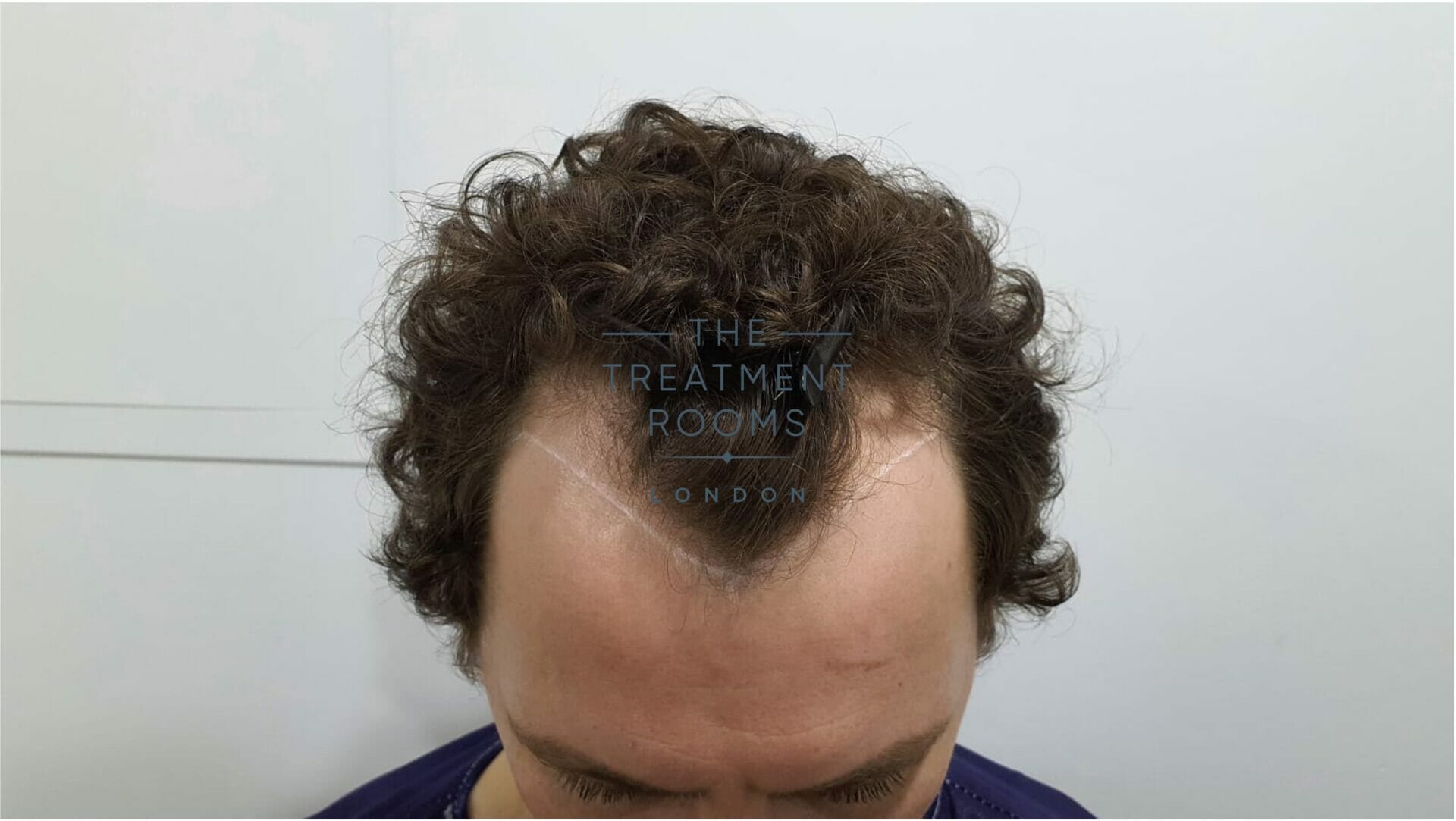
It is often the moment that my patients start to form a widow’s peak that they reach out to me to explore how having a hair transplant can help bring their hairline back
Dr Fernando, Hair Transplant Surgeon and Director at The Treatment Rooms London
Why is it called a widow’s peak?
You might have wondered where the term ‘widow’s peak’ comes from. The term originates from 18th-century England; at that time, a newly widowed wife would wear a triangular black hood or hat with a characteristic point that fell in the middle of the forehead, resembling the typical hairline pattern.
What causes a widow’s peak?
While there is insufficient evidence to conclude that a widow’s peak is entirely down to genetics, if someone in your family has a similar shaped hairline, you may inherit one too. While some men and women are born with a widow’s peak, others develop the pattern as their hairline begins to recede and thin in the temples, creating a “V” shaped hairline at the front.

Reverse widow’s peak.
There is another type of hairline termed a ‘reverse widow’s peak’. As you might expect, this pattern is the exact opposite of a widow’s peak, with a ‘V’ shape going in the opposite direction.
While a reverse widow’s peak may occur due to a receding hairline in men, the pattern is also associated with frontal fibrosing alopecia, an autoimmune condition which often affects women.
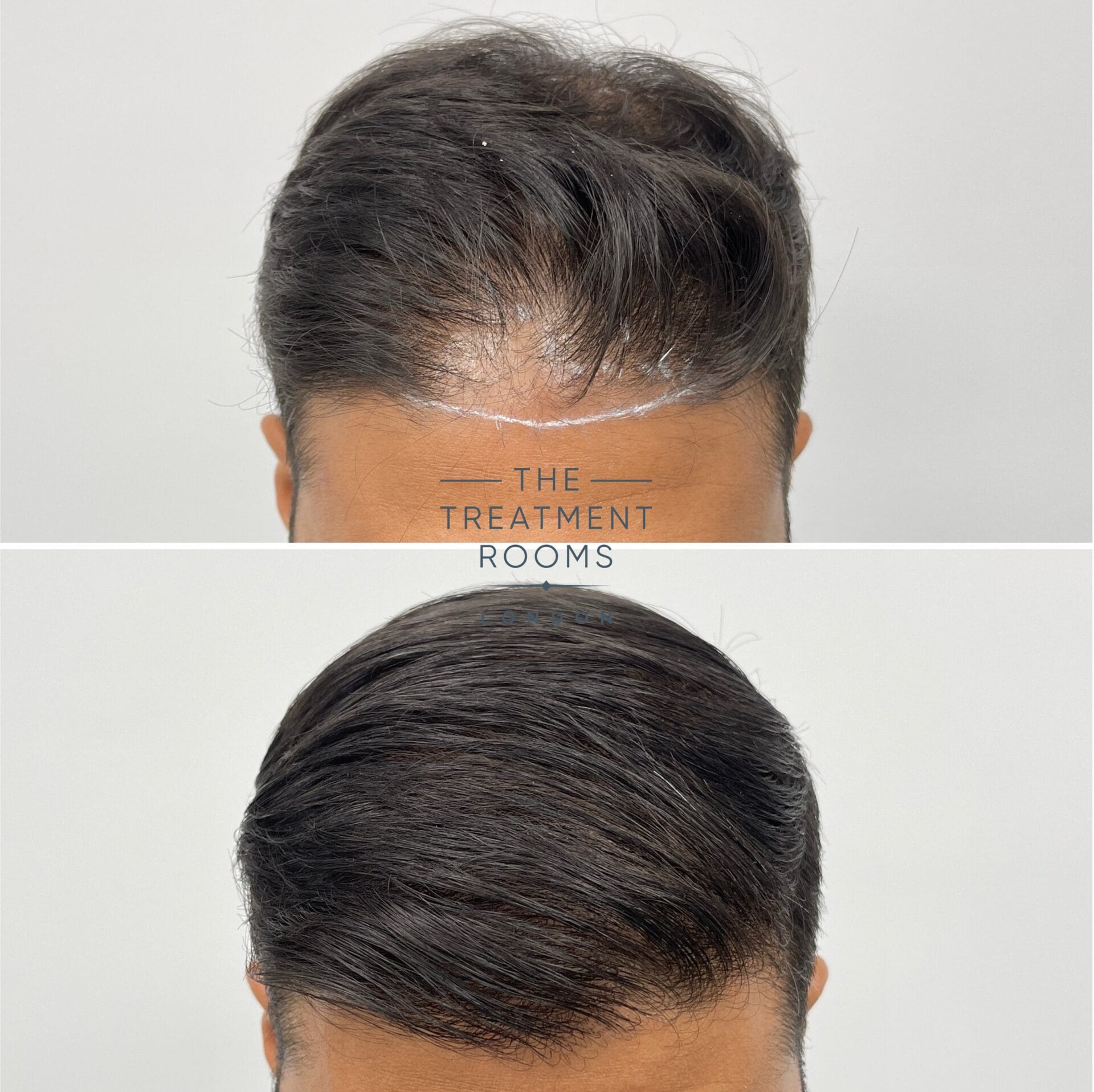
Some women with a reverse widow’s peak must have a biopsy taken before they have a hair transplant to rule out an autoimmune illness. This is because if they do have such a condition and undergo hair transplant treatment, the disease is likely to affect their new hair and compromise the success of their hair transplant.
Widow’s peak vs receding hairline
Like a widow’s peak, a receding hairline is a pattern of hair loss that is very common. A receding hairline can develop at any age but tends to affect men in their thirties and older.
Both a widow’s peak and a receding hairline (caused by male pattern baldness) can be hereditary and develop over time. The key takeaway here is that while a widow’s peak refers specifically to the ‘V’ shape pattern that people are born with and age with. A receding hairline is more of an umbrella term that can also refer to thinning and balding at the temples caused by an underlying condition like male pattern baldness, which can also lead to a “V” shaped hairline that mimics a widow’s peak. You can see an example of this below.
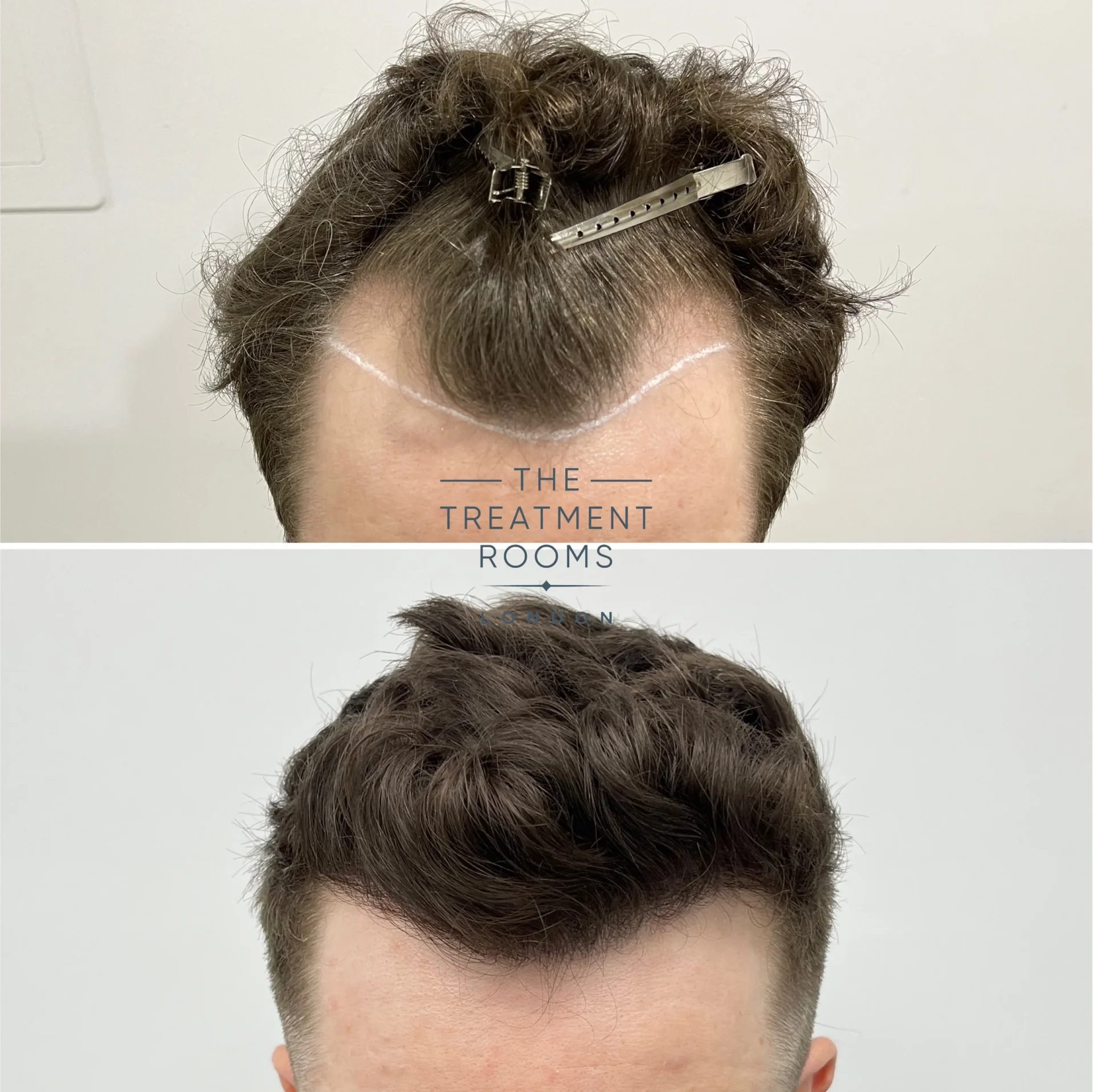
If you have always had a widow’s peak, it doesn’t mean you will develop a receding hairline. You may be born with a widow’s peak that doesn’t recede significantly. The main differences between a widow’s peak and a receding hairline are summarised below.
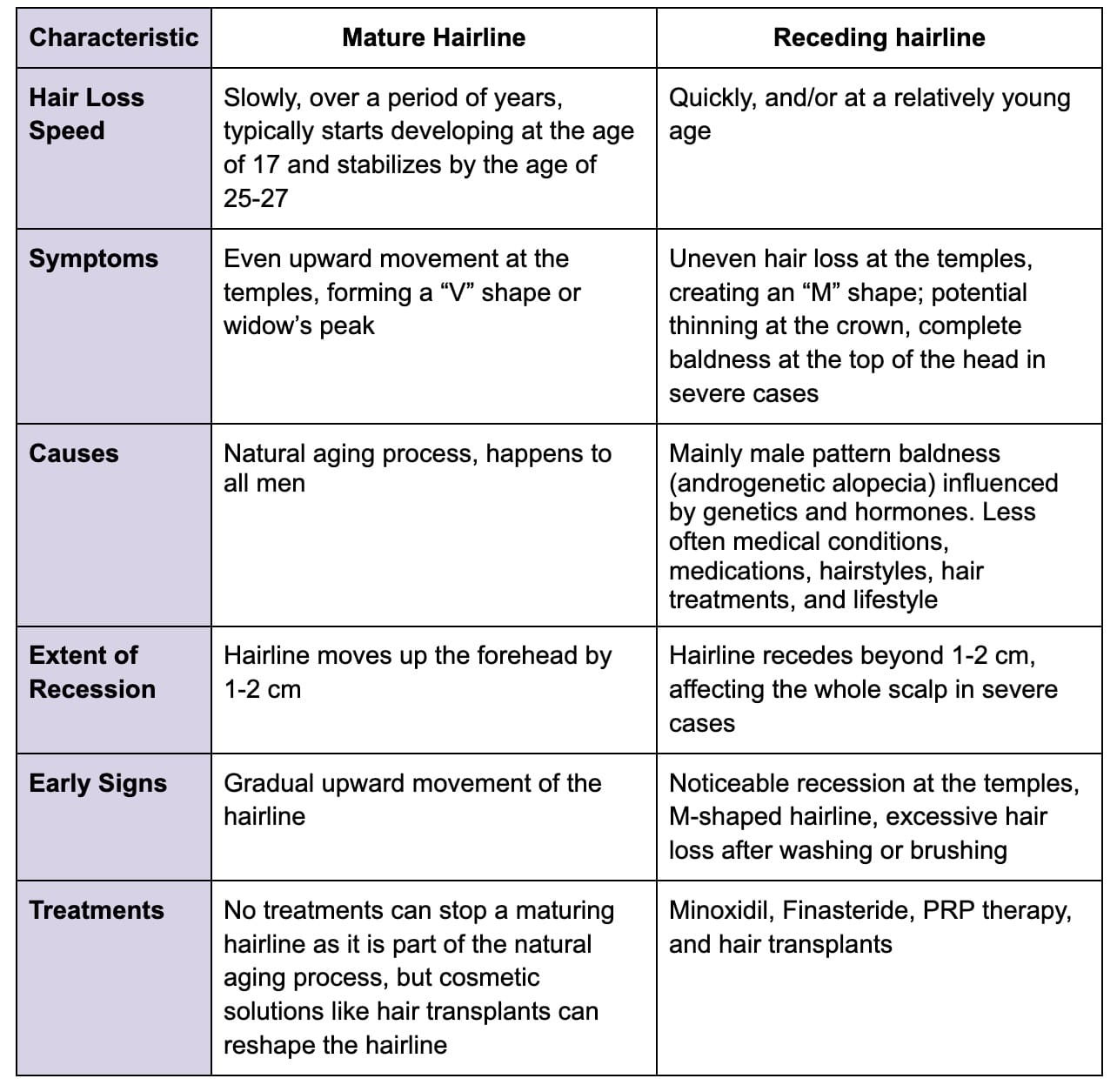
How to get rid of a widow’s peak
There are various ways that you can treat a widow’s peak. These include:
- Changing hairstyle: your barber or hairdresser can recommend a hairstyle that makes a widow’s peak less noticeable and improves your appearance
- Use hair removal creams: you can buy creams (depilatories) that remove hair and will slow regrowth compared to shaving
- Waxing: You can remove hair by applying a layer of hard wax and removing it
- Electrolysis: a technique that uses heat to remove individual hairs and prevent regrowth
- Laser removal: using intense light beams to destroy the hair follicles. This method can stop hair growth more effectively than most of the above methods.
- Hair transplant: A hair transplant can correct a widow’s peak, and we’ll discuss this option in more detail in the next section

Widow’s peak hair transplant
Patients can undergo a hair transplant to correct a widow’s peak. There are two main types of hair transplant: follicular unit excision (FUE) and follicular unit transplantation (FUT). Both of these techniques can soften a widow’s peak by adding new hair at the front and sides of the scalp, making your hairline appear straighter and giving it a more uniform look.
The FUE technique involves removing individual follicles from the back of your scalp using tiny punches. Follicles will then be meticulously placed on either side of the widow’s peak ‘V’ shape, above your forehead.
The FUT technique removes a strip of skin from the donor area at the back of your scalp before it is stitched in place. The strip is divided into smaller sections using a surgical tool and then implanted to soften the widow’s peak, similarly to FUE hair transplant surgery.
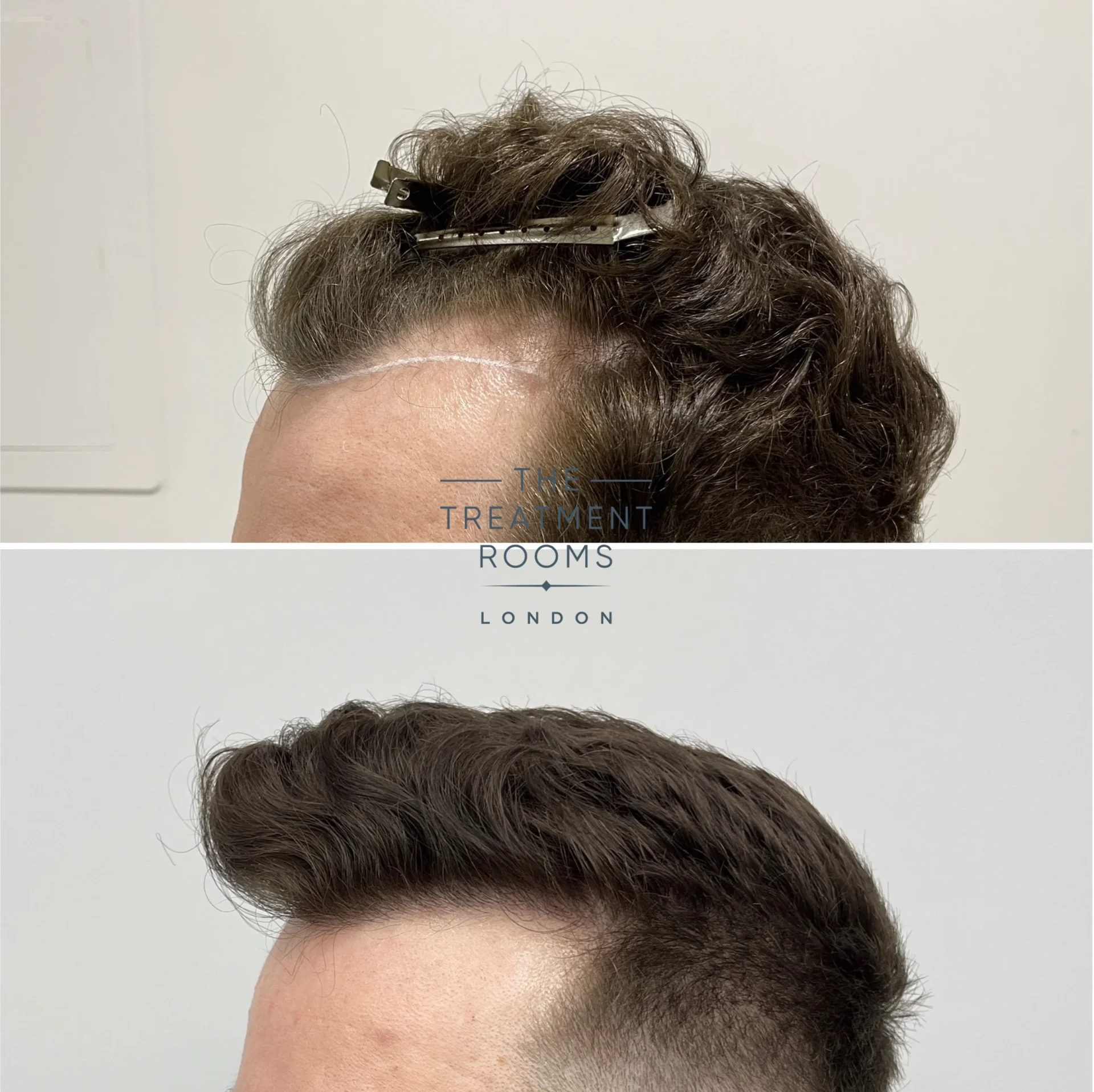
Widow’s peak hair transplant recovery
The recovery after a widow’s peak hair transplant should take between 5 and 10 days. Typically, patients can return to normal activities after two weeks have passed following their hair transplant. This coincides with the time that the grafts have become secure in the scalp following the procedure.
Widow’s peak hair transplant cost
Widow’s peak hair transplant cost
The main factor in determining the cost of a widow’s peak hair transplant is the number of grafts you require to restore your hair on either side of the peak. You can calculate the rough number of grafts you need in our graft calculator.
Most widow’s peak hair transplants will require 500-1800 grafts. An accurate assessment of how many grafts you need for a widow’s peak hair transplant can only be determined during a face-to-face appointment with a hair transplant surgeon. At The Treatment Rooms London, the cost ranges between £3,000 and £8,000, covering the number of grafts required for a widow’s peak hair transplant, which typically falls between 500 and 1,800. You can see a collection of widow’s peak hair transplants in our patient gallery.
Widow’s peak hair transplant graft number and cost
If you have lost a minimal amount of hair on either side of your widow’s peak, you will require less hair to be transplanted. This will result in a lower overall cost for your widow’s hair transplant.
Generally, hair transplant surgery for a widow’s peak can be categorised as small, medium or large in size.
Small widow’s peak hair transplant cost
Such cases can be seen here: small widow’s peak hair transplants, 500-900 grafts. The price for such surgery can range between £3,000- £4,500 and an example can be seen below.
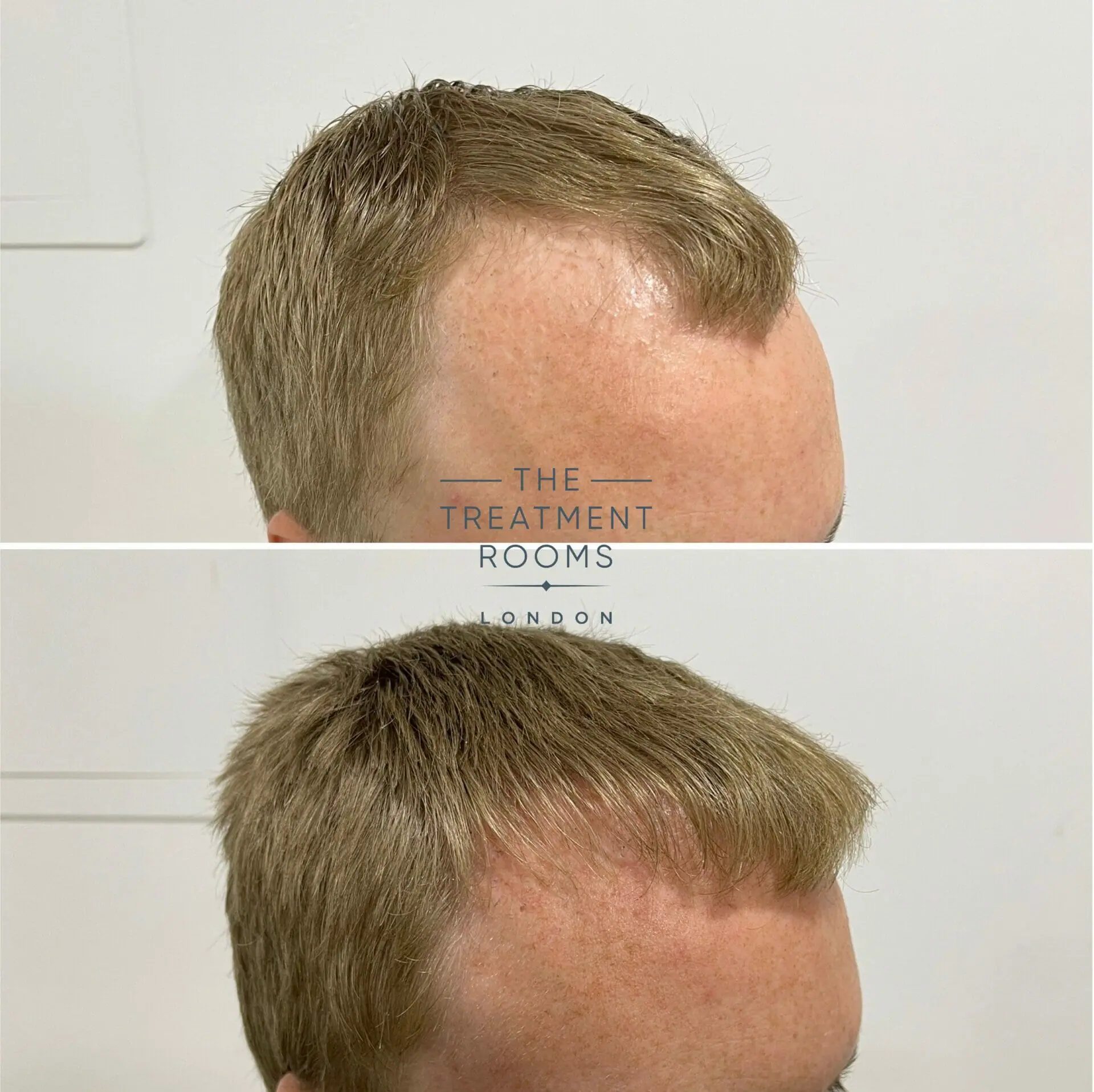
Medium widow’s peak hair transplant cost
You may have lost a moderate amount in your temples, creating a deeper widow’s peak. This might require 900-1400 grafts to soften the widow’s peak appearance. As a result the cost for a medium sized widow’s peak hair transplant will range between £4,000- £5,500.
Can women undergo hair transplant surgery to achieve a widow’s peak?
Women with a congenitally high hairline, which can create the appearance of a widow’s peak, or those with a condition that has caused them to develop one, such as temporal triangular alopecia, may be candidates for a hair transplant to address a widow’s peak.
A female widow’s peak transplant can help soften the “peaked” appearance of their hairline. It is performed over one day, and it may also be a procedure performed as part of hairline lowering. Women can opt to have either the FUE or FUT technique for their procedure, and it will depend on the size of the area that needs to be operated on.
Trans patients and widow’s peak hair transplant surgery
At our clinic, we find our transgender patients often like their widow’s peak operated on to reduce its appearance. This can often be a part of a hairline feminisation procedure. You can read more about the services we provide for our trans patients on our dedicated page- transgender hair transplant surgery.
Book a consultation
At Treatment Rooms London, we can offer both types of hair transplants to correct a widow’s peak. Our experienced surgeons will guide you through the best options for your hair. To book a consultation, use our contact form or call 020 8706 0076.
Share:
Authored by
Reviewed by
Book a Consultation
Related Blogs
Castor Oil (Ricino Oil) for Hair Growth: Benefits, Uses & How to Apply for Maximum Results
June 26, 2025
Castor oil, also known as Ricino oil, is extracted from the Castor bean plant (Ricinus communis). During…
What is a Hair Transplant? How it Works, Success Rate & What to Expect
June 23, 2025
Hair transplantation is a cosmetic surgical procedure that restores hair by moving healthy follicles from one part…
John Cena Hair Transplant
May 14, 2025
John Cena, a common household name, is a figure who has effortlessly straddled the worlds of professional…
Kyle Walker Hair Transplant: Before, After, and His New Hairline
May 12, 2025
Kyle Walker is known for his defensive skills at Tottenham Hotspur, Manchester City, and in the England…
Celebrity Hair Transplants: Full Before and After Analysis
May 8, 2025
Elon Musk Hair Transplant Elon Musk, the billionaire behind Tesla and SpaceX, is well-known for his innovations…
Lewis Hamilton Hair Transplant: Before, After, and His New Hairline
May 7, 2025
As a top-class racing driver, Hamilton is used to wearing a race helmet. While this does protect…
James Nesbitt Hair Transplant: Before, After, and His New Hairline
May 6, 2025
James Nesbitt, the Northern Irish actor famed for his role as Adam Williams in the British comedy-drama…
How Many Hair Grafts Do You Need For A FUE Hair Transplant?
May 3, 2025
An Follicular Unit Excision (FUE) or FUT hair transplant are 2 main procedures available to address hair…
Cristiano Ronaldo’s Hair and Hairline
May 2, 2025
Cristiano Ronaldo, the football icon, is celebrated as much for his on-field brilliance as his impeccably groomed…











